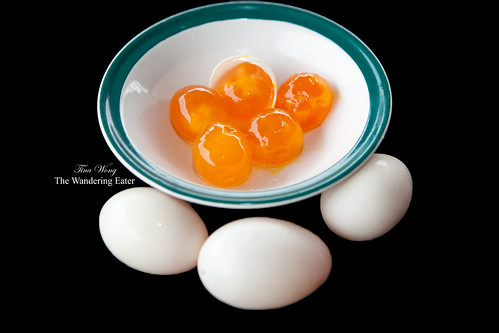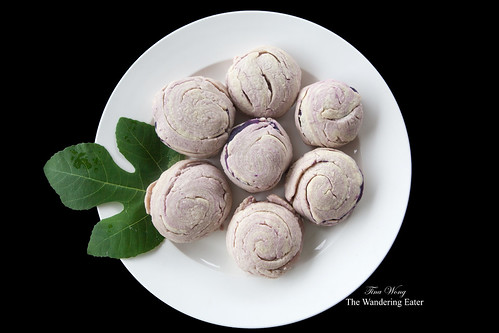

Traditional mooncakes (before and after baking)
Mid-Autumn Festival is coming up soon (this year, it’s September 19th) and it seriously felt maybe a week or two ago I made these traditional Chinese pastries – the traditional mooncakes (廣式月餅) and the snowskin mooncakes. I’ve been making these ever since for my family and a few close friends and they always wanted a few of these pastries once they start seeing it at the Chinese grocery stores and bakeries.
This year, I did not make any snowskin mooncakes and made traditional mooncakes (what you see at the beginning of the post) and the Taiwanese-style flaky mooncakes (台灣芋頭酥) with homemade taro and purple sweet potato pastes to make things more interesting for myself.


Fillings: Homemade taro and purple sweet potato pastes and homemade salted duck eggs
The pastes are not as difficult and intimidating as it seems. The large taro root has to be peeled, cut into medium-sized chunks and steamed until it is soft enough that when you use a small knife and poke it, there’s almost no resistance. Then you would purée the darn thing into a smooth paste with granulated sugar and extra virgin coconut oil or a neutral flavored oil like vegetable or canola, if you prefer not to have a slight coconut flavor. Same thing applies to the purple sweet potato.
Inclined to try? Here’s the recipes for the taro root and the Taiwanese style mooncake:
Taro root paste (芋頭膏)
Yields about 2 1/2 cups or 800 grams
Ingredients:
900 g (2 pounds) taro root
150 g (2/3 cup) granulated sugar
300 g (about 2 tablespoons) melted unsalted butter, melted lard or oil (could be coconut oil or any neutral flavored oil)
1. Preheat the steamer. Peel and cut the taro root into 1-inch chunks and steam it until it is tender (about 10 minutes). Insert a small knife into one of those taro chunks to see if there’s any resistance. If not, it’s ready to be puréed in the food processor or even better, pressed through tamis sieve with a large bowl underneath it to catch the milled taro.
2. Mix the granulated sugar and fat while the taro is still hot. Take the mixture and place it into a large wok or any cooking vessel to evaporate out excess water from the taro root mixture in a low fire and constantly stir. A wet paste makes it harder to work with in these pastries and it becomes a mess to shape and form. The best way to know when the paste is ready is when your wooden spoon can stand up on its own when you place it in the mixture. Remove it from the fire and transfer the taro paste into a large bowl or container, set aside to cool.
Taiwanese-Style Mooncakes (台灣芋頭酥)
Yields about 1 dozen mooncakes
Ingredients
“Water” dough:
200 g all purpose flour
1 teaspoon white vinegar
100 g lard (or unsalted butter)
60 g sugar
100 g water
Mix all ingredients in a bowl until it forms a soft dough. Let rest for 20 minutes before dividing into 8 portions (or more depending on the size of pastry you want). Set aside.
“Oil” Dough:
360 g all purpose flour
200 g lard (or unsalted butter)
Combine all ingredients and divide into the same number of portions as the water dough.
To make the spiral shaped mooncake:
Ingredients:
The two doughs, mentioned above
Taro root paste
1. Wrap water dough over oil dough (as in a ball). Roll out into a long rectangle then envelope fold the sheet of dough (as in fold into thirds), roll flat.
2. Envelope fold the sheet of dough (as in fold into thirds), roll flat then roll tightly like Swiss roll cake or roulade.
3. Cut the roll into 8 pieces.
4. With spiral side facing up, roll out the cut dough large enough to cover the filling. Wrap over filling and press in the seams together and set it on a parchment or silicone mat lined baking sheet. Repeat with the rest of the dough with a half inch space in between each pastry.
5. Bake at 325°F for 25-30 minutes until the edges barely get golden. Set aside to cool. Best eaten the day of but will keep for 3 days.





